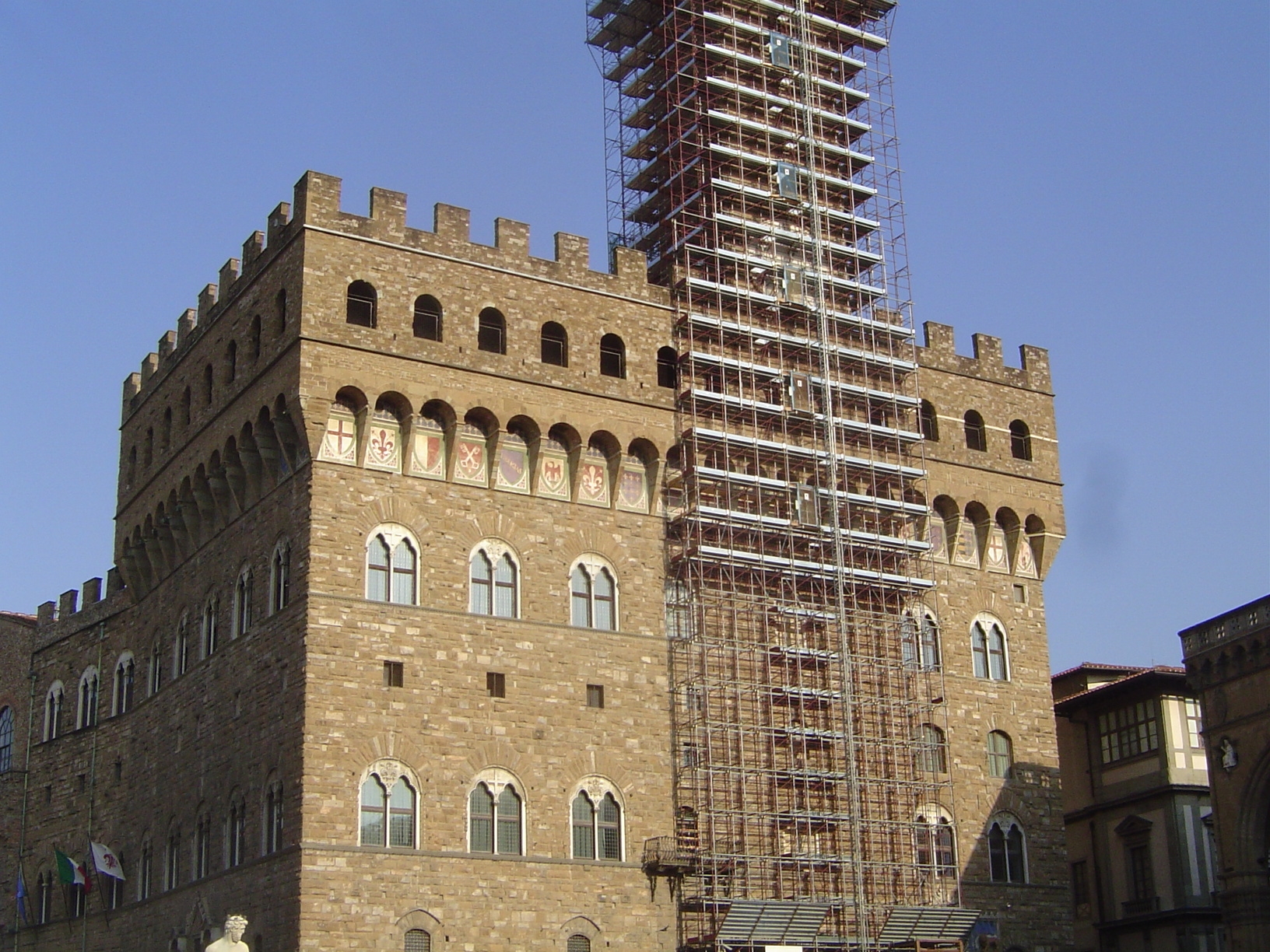
The Florentine palace is the global model for thousands of banks and government buildings. Ironically, the Florentine palace isn't very palatial: it's too confined, more or less filling up a city block with a masonry cube.
It can be unsettling to Americans to wander around Florence all day without seeing a single police car. A thousand years ago, however, this place, like the rest of Europe, was dangerous. That's why the city by 1200 had some 150 tower houses, whose doubled walls may have been filled with gravel but whose towers symbolized family power and prestige. In 1250, the city limited the towers to 50 braccia, about 100 feet. At about the same time, a more effective limit was imposed by the warfare between the Guelphs and Ghibellines, which reduced most of the towers to ruins.
So much for the rationale behind the Palazzo Vecchio, or "old palace," which combines the elements of a fortress with those of a house, for example with its fair-sized windows. It was begun in 1292, when the tower-house had already run its course and when building one was more an appeal to tradition than functional necessity. The architect was Arnolfo di Cambio, who previously had begun Santa Croce. At various times, the building has had other names, including the Palazza della Signoria and the Palazzo Ducale, a name adopted when it became the residence of Grand Duke Cosimo I. The name Palazzo Vecchio came into use after 1549, when the Medicis moved across the river to the Pitti palace.
This could almost be part of a public building in any American downtown, but it's the back side of the Palazzo Vecchio, and the inscription is a reminder of its time as the ducal palace.
The ashlar blocks are as much a part of Renaissance Florence as limestone is of modern Jerusalem, and in both cases it's a matter of law—in this case, a Florentine law of 1389 requiring pietro dura facing for all buildings visible from the Via Calzaioli, which runs from the cathedral toward the river.
This is the Bargello, literally the police station; it's a trifle earlier than the Palazzo Vecchio and was built in 1255 as the residence of the podesta, or chief magistrate of Florence.
Inside, there's a cortile, or courtyard, with stairs to the grand rooms on the piano nobile.
By the 15th century, a new form had evolved: this is its archetype, the Palazzo Medici-Riccardi, finished in 1444 and designed by Michelozzo for Cosimo il Vecchio. Classic as it is, its proportions were heavily altered by the Riccardi family, which bought the place, found it too small, and added another seven bays at the far end.
The addition is seen here from around the corner, where it appears almost as an elaborate false front abutting an open but walled courtyard. Notice how the rusticated ashlar is smoother at higher levels, which creates an illusion of greater height.
More than a hundred such palazzi were begun between 1450 and 1500. This one is the Strozzi, built between 1489 and 1504 by de Maiano. Sometime during the family's long residence, oil-cloth sheeting was replaced by window glass.The Strozzi family occupied the palace until 1938, when (wouldn't you know it?) an insurance company moved in. Today it's a museum.
Brunelleschi's Pitti Palace, which began life as a cube at the center of the three-story block. Vasari says that even that original plan was rejected as too ostentatious by Cosimo de Medici. It was welcomed by Pitti, but—there's an architectural law in the making here—later generations found the space inadequate. The palace kept growing until 1819. A century later Victor Emmanual III had the good sense to find it too large. He gave it to the state.
The rusticated facade is carried to an extreme at the Pitti's ground floor, but perhaps the unshaved, tough-guy look made a serviceable substitute for electronic security systems.
Another view of the same wall, showing the smoother texture of the upper floor.
The other side of the Pitti palace faces the Boboli Gardens. The facade here is late—1568—and by an architect, Ammannati, who reduced rustication to tinker toys.
Or donuts.
Inside, the palace is a fine reminder of the bizarre spaces that European royalty called home.